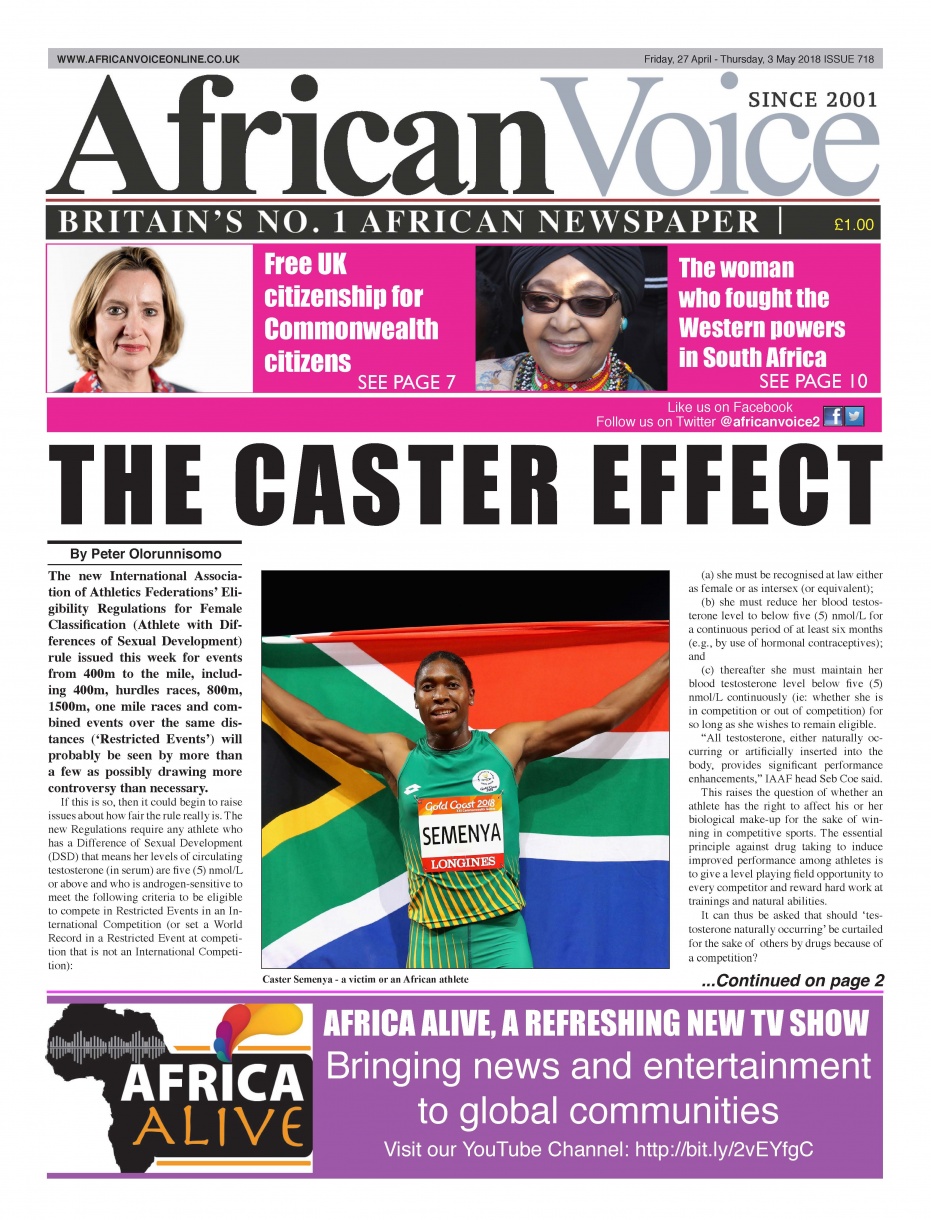By Peter Olorunnisomo – The new International Association of Athletics Federations’ Eligibility Regulations for Female Classification (Athlete with Differences of Sexual Development) rule issued this week for events from 400m to the mile, including 400m, hurdles races, 800m, 1500m, one mile races and combined events over the same distances (‘Restricted Events’) will probably be seen by more than a few as possibly drawing more controversy than necessary.

If this is so, then it could begin to raise issues about how fair the rule really is. The new Regulations require any athlete who has a Difference of Sexual Development (DSD) that means her levels of circulating testosterone (in serum) are five (5) nmol/L or above and who is androgen-sensitive to meet the following criteria to be eligible to compete in Restricted Events in an International Competition (or set a World Record in a Restricted Event at competition that is not an International Competition):
(a) she must be recognised at law either as female or as intersex (or equivalent);
(b) she must reduce her blood testosterone level to below five (5) nmol/L for a continuous period of at least six months (e.g., by use of hormonal contraceptives); and
(c) thereafter she must maintain her blood testosterone level below five (5) nmol/L continuously (ie: whether she is in competition or out of competition) for so long as she wishes to remain eligible.
“All testosterone, either naturally occurring or artificially inserted into the body, provides significant performance enhancements,” IAAF head Seb Coe said.
This raises the question of whether an athlete has the right to affect his or her biological makeup for the sake of winning in competitive sports. The essential principle against drug taking to induce improved performance among athletes is to give a level playing field opportunity to every competitor and reward hard work at training and natural abilities.
It can thus be asked that should ‘testosterone .. naturally occurring’ be curtailed for the sake of others by drugs because of a competition? Meanwhile, the use of drugs in sports is banned when the drug is seen as enhancing the user’s ability to do better unnaturally.
One instant implication of this rule hits embattled South African athlete, Caster Semenya, who reportedly told journalists that ‘she has no time for nonsense’, when asked about the impending IAAF regulations that could require her to take medication to reduce testosterone levels.
Asked by a journalist whether she would comply with the regulations set to be announced on Thursday, Semenya said she’s more concerned with keeping in shape in order to compete.
‘‘I have no time for nonsense. Medication or no medication, I am an athlete. My focus is more on getting healthy to compete”, Semenya said.
For someone like Caster, who has suffered immensely and emotionally from being ‘castigated’ as a male running in a female field, the exasperation cannot be less vituperative. It probably would not have happened to any other international star athlete outside Africa who enjoys the positional support of her country or region and of political muscle.
It is significant that she was cleared of being male or being a male-hormon-ic female aside from the various aspersions in the press than about her beard-growing face, male-looking set head, etc.
Semenya, double Olympic and triple world champion over 800m and who completed the 800-1500 double at the Commonwealth Games this month, has always been a controversial figure in the sport as its authorities have sought a solution that respected her rights while also providing a “level playing field”.
The 27-year-old’s powerful physique and deep voice, followed by the revelations of her hyperandrogenism, left some rivals complaining that they faced an impossible and unfair challenge.
The famous celebrity model, Grace Jones, was once quoted complaining that when she started modelling, “everybody thought I was a man.”
If her complaining rivals feel unfairly set against her, it would be appropriate to know field their opinions directly. It raises such questions, “Would Semenya always win her races with this ‘advantage’ for life?” As she ages, would she remain unbeaten and by whom – someone who also has the disadvantage or advantage of nature-occasioned hyperandrogenism or no one else? These are questions which the IAAF should also consider.
It is reported that media in the UK and South Africa on Wednesday published sections of the report ahead of its official release, revealing that the new hyperandrogenism regulations would include a separate female classification to be known as an Athlete with Differences of Sexual Development (DSD).
“Experts consulted by the IAAF have gathered and reviewed all of the published evidence and data, which indicates that increasing the level of circulating testosterone from the normal female range to the normal male range leads to increased muscle mass and strength and higher haemoglobin levels,” the report, which has not been seen by Reuters, is reported to have said.
The IAAF’s medical advisors have suggested the advantage held by DSD athletes is far less pronounced in short sprints or long distance endurance races, leaving the door open for Semenya to move up to 5,000 or 10,000 metres if she desires.
The South African began raising eyebrows when she won the world junior championships in 2008 and the senior world title the following year, with a dramatic improvement in her times.
The IAAF made Semenya take a sexual verification test, which was initially kept secret but revealed by the media in 2009.
Since then virtually all of Semenya’s performances have been followed by questions about her sexual and physical status, but she has long stopped answering them.
It is thus key to consider what sports administrators does consider and the deep concerns of their considerations as affecting not just the individuality of the talented individual who just exploits a natural disposition to sports for an income but also the future possibilities of the same incident occurring and the implications therefrom if they erred in their primary treatment of the context.
If that can’t be invaluable to decisions as this, then the search for a political ‘antiseptic’ might just be very appealing.
Kindly follow us on twitter:@AfricanVoice2










